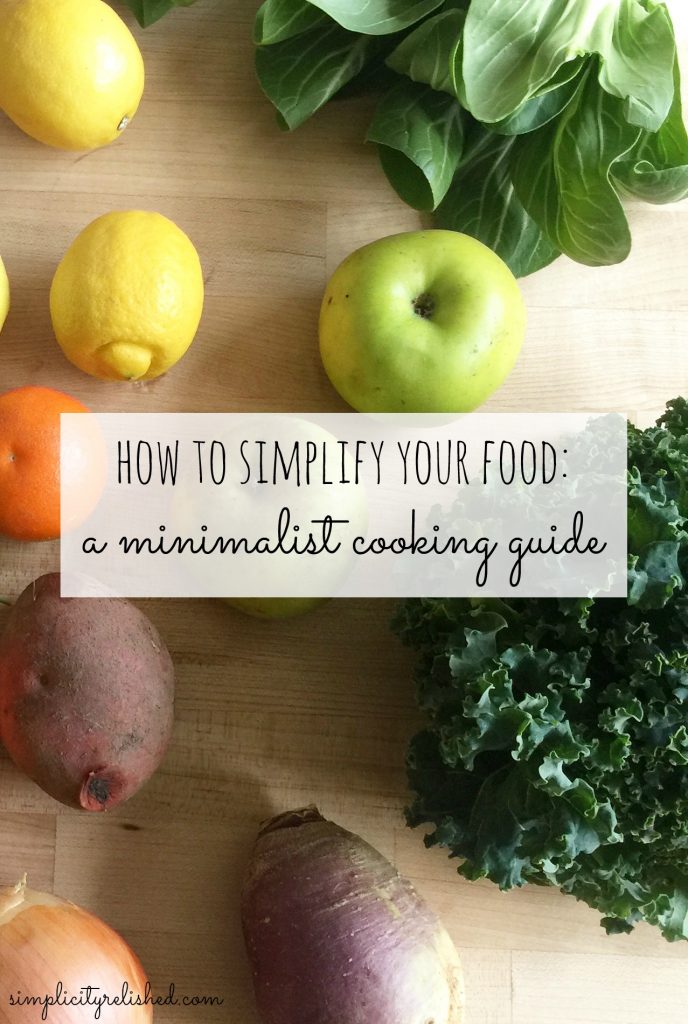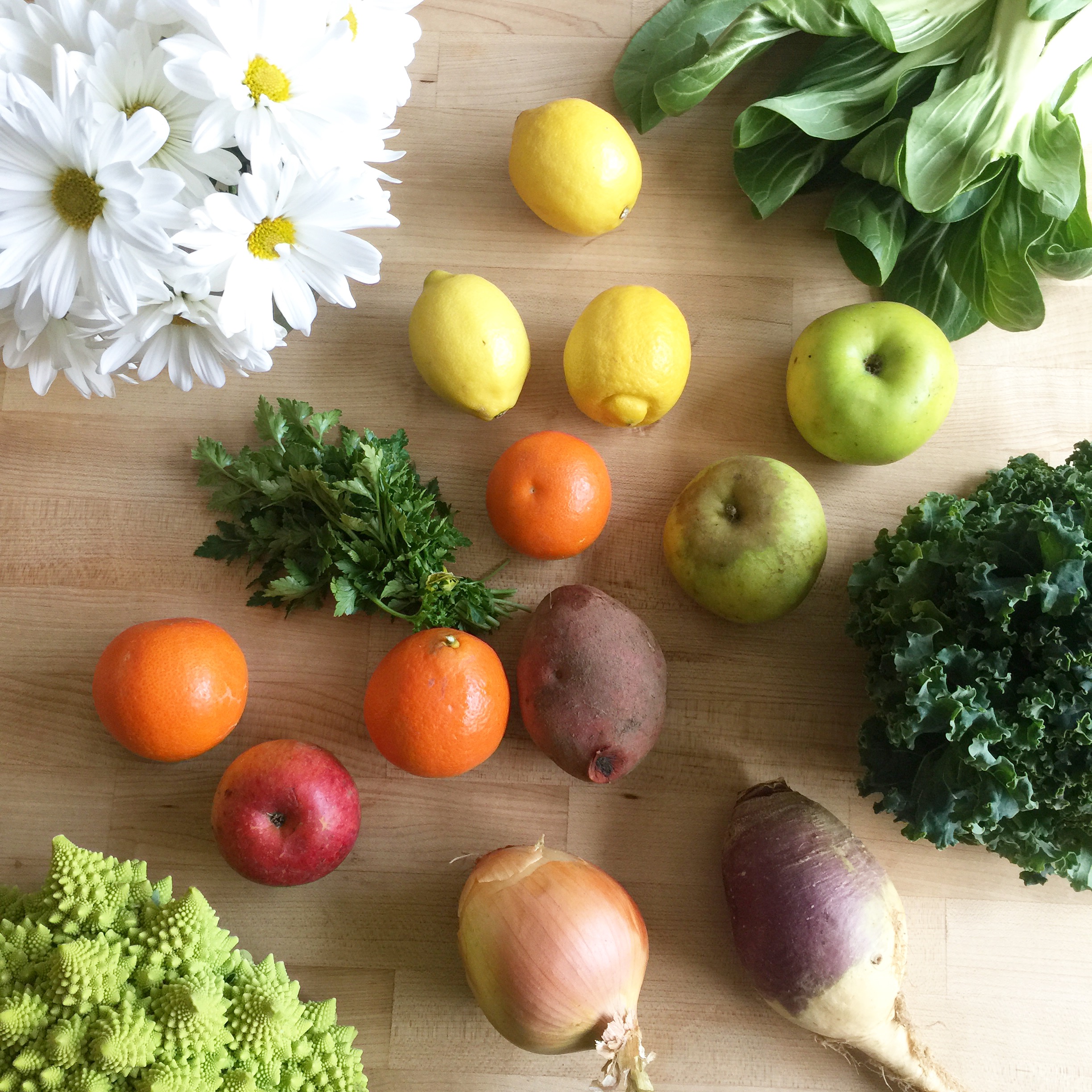My husband and I are foodies. We’re also enthusiastic home chefs.
We own too many cookbooks and more appliances than the average person. Our entire wedding registry is mostly in the form of a kitchen tool. And we use all of it.
But here’s the thing– we believe in simple food. And this actually squares quite well with how much time we spend in the kitchen.

Over-processed and under-nourished
I don’t think I have to explain here that modern processed foods– freezer meals, fast food restaurants, almost anything that comes from a factory– have been shown to lead to all kinds of health issues. This is not only a personal, domestic injustice; it’s social, environmental, and increasingly global.
Perhaps even more serious is that many of us are fully dependent on processed foods because we don’t know how to cook with raw materials. We also have no idea where our food comes from.
Recently, I’ve started deeply appreciating the beauty and nuanced flavors of farm fresh produce. The nuttiness of cauliflower. The umami of kale. The buttery-ness of sweet potato.
And I’ve been in pursuit of strategies to enjoy the freshness of fruits and vegetables with as little dressing-up as possible.
You see, the food-lover in me is ready to get closer to the earth. To wash dirt off my carrots, pick basil from my yard, and sink my teeth into freshly-picked berries.
And what I love most about this journey? While there are hundreds of diet persuasions out there (only some of which are substantiated by research), no one will argue that you shouldn’t eat veggies. We all know we should– and I love making them the center of our simple meals.
Less process, more nourishment.
Simplifying meals for body and mind
Let me make something quite clear. Simple doesn’t always mean easy. I think we often equate the two, because we love the idea of an easy life.
But living according to your convictions– whether that means resisting clutter, choosing generosity, or protecting your health– is not easy. It’s worth it.
So simple eating comes down to a couple mental shifts.
- Shift your expectations. Simple, natural food might not taste like pizza delivery or greasy takeout. It’ll taste exactly like what you put into it. And what you put into it will evolve in sophistication as you learn to use what you have on hand.
- Shift your strategy. Simple eating requires planning, and at first this can be overwhelming. Saying no to going out to yet another meal at Chipotle can mean cooking rice overnight, prepping large tupperwares of lentil stew, or chopping vegetables over the weekend. Simple eating may take more time– as you’re not relying on factories and restaurants to do the cooking for you. This can be a very real sacrifice for a lot of people.
And here are two ways that simple eating will benefit you.
- Your body will thank you. Whether you cut out certain food groups is up to you– but you’ll be better nourished when the food you eat is closer to its original raw form.
- You will experience more appreciation for food. Your mindset with food will shift, and you’ll likely experience less stress around food. Everything you eat will be good for you. You’ll know where it comes from. You’ll experience more peace and even gratitude for earth’s bounty.
Grocery shopping made simple
Unless we’re strolling through the farmer’s market on Saturday morning (one of my favorite activities), we spend very little time shopping for food. Here’s how we do it.
- We subscribe to our local Community Supported Agriculture. This is a weekly box of fruits and vegetables delivered to our neighborhood. Everything is organic and local! I always build our menu around what we get. It’s a fun challenge to finish our box before the week is over.
- We supplement with one grocery run per week and monthly trips to Costco. Our weekly grocery list is nearly always the same– occasionally replenishing any stores that are out. We buy dried goods, dairy, eggs, and meat if necessary. it usually takes about 20 minutes! Then every month or two, we go to Costco to stock up on bulk supplies that we use regularly (broth, canned tomatoes, frozen fruit, Kerrygold butter and wine).
A minimalist approach to weekday meals
I’m not a recipe developer (at least not on this blog anymore), but that’s kind of the point. You don’t need to follow recipes too closely once you’ve got your bearings in the kitchen.
Here’s how we usually put our meals together during the week.
- Identify fruits and vegetables in our refrigerator and how we want to eat them. This could mean stir-frying, roasting, lightly frying, or serving raw.
- Identify grains or proteins we want to serve with the veggies. This is usually rice, pasta, beans, lentils, meat, or some combination.
- Identify the flavor profile we want each component to have. This is the fun part! I know herb and spice combinations by heart (you can also purchase pre-mixed spice blends or sauces)– and regularly choose between Mexican, Italian, Spanish, Chinese, Japanese, Korean, Vietnamese, Moroccan, and Mediterranean. Most vegetables do well with nearly every flavor profile (how ubiquitous are onions!!), so this approach tends to serve us well.
To streamline our cooking, we usually have various components of meals in glass containers in our refrigerator at any given time. If we make dinner, we’ll save leftovers for lunch. If we make breakfast porridge (overnight oats in cashew milk, anyone?), we’ll make enough for multiple days.
[Tweet “Simplify your food- a #minimalist guide to simple eating via @daisysrosales”]
What kitchen appliances do I need?
Friends who are newer to cooking often ask us what tools are absolutely necessary in the kitchen. While I’m still convinced that a high-quality pan and knife are the bare necessities, we’ve really found far more cooking bliss with the following:
- Vitamix blender: this thing has endless uses– if I had to choose one electric appliance, I’d go with this. Juices, smoothies, nut milks, blended soups (so good), ice cream, sauces, and more.
- Slow cooker: We use our slow cooker almost every week. It’s perfect for stews and braises, melding ingredients together without supervision.
- Food processor: okay, hear me out– this is different from the blender. This can shred veggies, make nut butter, and pulverize practically anything. It’s especially useful if you’re into vegan cooking blogs (like Minimalist Baker).
- Rice cooker: If you love grains and beans, this is worth considering. Yes, you can cook grains and beans on the stove, but a rice cooker will do it to perfection without you having to monitor the cooking. We love our rice cooker and use it all the time.
Simplify and savor
The best thing about simple eating is that you’re likely to actually enjoy food more. Sure, not every weekday meal will be slow, but you’ll find yourself benefiting from a brand new rhythm.
What other strategies do you have for simplifying food? I’d love to know!


Hey Kathy! You are very close indeed. I’ve found it helpful to work off of recipes that I love, using ingredients we already have. I love Bon Appetit’s Healthyish blog. Check it out! https://www.bonappetit.com/healthyish/recipes
I am trying to simplify my meals. I have breakfast and lunch under control but spend a lot of my time searching for healthy evening meals that are delicious all within the guidelines of my food plan: Bright Line Eating (no sugar or flour). It is my hobby. I want to make eating more automatic and not focus so much on food. I eat only whole foods but I want to shed myself from all the recipes I rely on. I know how to cook and have all the kitchen appliance mentioned including a wonderful Wolf stove. I’m probably closer than I think. I need help. Simple help.
Thanks so much Natasha! Keep me posted on how things are going!
What a great approach to simplify meal planning! This is essentially what we do too, creating most of our meals based on what is in season, using whole foods as much as possible. (although definitely an area I’m trying to improve in – as a mother of small children I can sometimes feel like I don’t have time to cook healthy, but I’ve made huge adjustments and improvements in my children’s mealtimes during the past year). Thanks for the “food for thought”!
Yes!! Those things are really useful when you’re becoming a home cook. And I love savory too!
Thanks, friend. I appreciate that. <3
That sounds delicious, Linda!!
Thanks Kathryn!! Glad we’re in this together– and the Vitamix is definitely one of those tools we use everyday!
Yes!! That’s an awesome strategy. Raised planters sound awesome!!
It’s so great. You can definitely ask at your local farmer’s market if there’s a CSA near you!
Aw yay! So glad to hear that, friend.
Thanks Joi!!
Thanks Alyssa!!
Love this post! Bringing simplicity and intention to the pantry will make things so much easier.
awesome tips, thanks
I’ve gotten back into my raw foods/paleo diet again…couldn’t agree more with the over processed bit
xo
http://thejoifullife.com/
You’re really inspiring me to think differently about food! I really love this post, Daisy! <3
That organic box sounds like such a great thing! I wish I had one near me. I also love the idea of keeping things simple and then adding spices. Maybe learning my spices should be a new years goal….
xx, Pia
http://gymbagsandjetlags.com
Our biggest saver is simple meal planning – and we plan meals where the ingredients we have or the meal we make will make yummy left-overs. We’re all about the home garden as well, and can’t waited to get started on ours! I’ll be building raised planters in the spring!
Love this post! I’m in the kitchen all the time & am trying to find more ways to simplify my food as well. There are seasons in my life where I’m much more in tune with what I’m eating and I feel so much better every day. I strive for consistency, even though it is challenging to simply your life & your food. But once you get there, it’s amazing. I might have to put that Vitamix on my Christmas list! 🙂
My newest rick is to make batches of flavored butters. Melting some on nearly any meat or vegetable changes the flavor quickly and easily while increasing its satiety.
I love these strategies, but even more so, I love your heart and passion behind slow eating. I’ve never really had a desire to go so far as to grow my own food, but I deeply appreciate the beauty and wholeness of eating real food. I can’t imagine ever going back to my processed-food ways from so many years ago! It’s a sacrifice of time and sometimes money to eat this way, but I totally agree that it’s what’s best for everyone’s health long term.
What I discovered that I’m missing in my flat share, are a pressure cooker and a mixer. And I’m working on having a wide array of herbs available. Lately I’ve discovered that I really like savory.